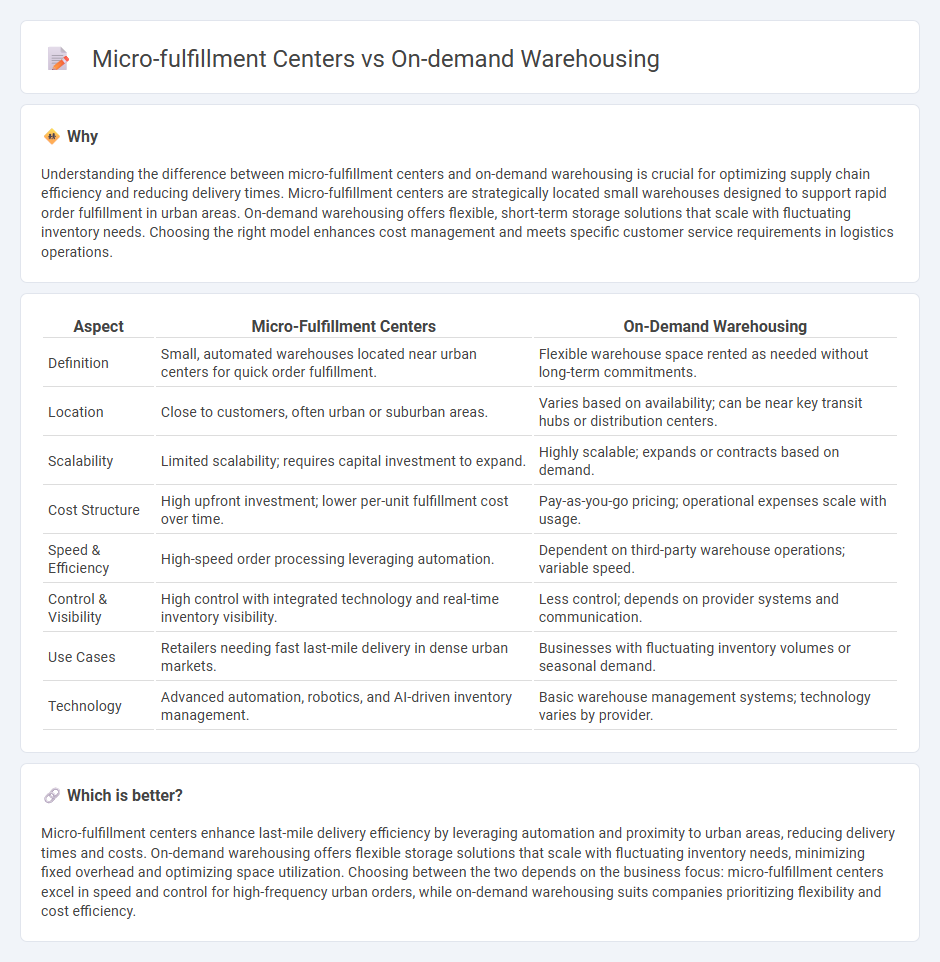
Micro-fulfillment centers enhance last-mile delivery efficiency by utilizing automation technology in urban areas, reducing order processing time and transportation costs compared to traditional warehousing. On-demand warehousing offers flexible storage solutions by allowing businesses to rent space based on fluctuating inventory needs, optimizing supply chain agility during peak seasons or unexpected demand surges. Explore how these innovative warehousing models can transform your logistics strategy and improve operational performance.
Why it is important
Understanding the difference between micro-fulfillment centers and on-demand warehousing is crucial for optimizing supply chain efficiency and reducing delivery times. Micro-fulfillment centers are strategically located small warehouses designed to support rapid order fulfillment in urban areas. On-demand warehousing offers flexible, short-term storage solutions that scale with fluctuating inventory needs. Choosing the right model enhances cost management and meets specific customer service requirements in logistics operations.
Comparison Table
| Aspect | Micro-Fulfillment Centers | On-Demand Warehousing |
|---|---|---|
| Definition | Small, automated warehouses located near urban centers for quick order fulfillment. | Flexible warehouse space rented as needed without long-term commitments. |
| Location | Close to customers, often urban or suburban areas. | Varies based on availability; can be near key transit hubs or distribution centers. |
| Scalability | Limited scalability; requires capital investment to expand. | Highly scalable; expands or contracts based on demand. |
| Cost Structure | High upfront investment; lower per-unit fulfillment cost over time. | Pay-as-you-go pricing; operational expenses scale with usage. |
| Speed & Efficiency | High-speed order processing leveraging automation. | Dependent on third-party warehouse operations; variable speed. |
| Control & Visibility | High control with integrated technology and real-time inventory visibility. | Less control; depends on provider systems and communication. |
| Use Cases | Retailers needing fast last-mile delivery in dense urban markets. | Businesses with fluctuating inventory volumes or seasonal demand. |
| Technology | Advanced automation, robotics, and AI-driven inventory management. | Basic warehouse management systems; technology varies by provider. |
Which is better?
Micro-fulfillment centers enhance last-mile delivery efficiency by leveraging automation and proximity to urban areas, reducing delivery times and costs. On-demand warehousing offers flexible storage solutions that scale with fluctuating inventory needs, minimizing fixed overhead and optimizing space utilization. Choosing between the two depends on the business focus: micro-fulfillment centers excel in speed and control for high-frequency urban orders, while on-demand warehousing suits companies prioritizing flexibility and cost efficiency.
Connection
Micro-fulfillment centers and on-demand warehousing are interconnected by their ability to enhance last-mile delivery efficiency and optimize inventory management in logistics. Micro-fulfillment centers use automated systems to rapidly process orders near urban demand hubs, while on-demand warehousing provides scalable, flexible storage solutions that adjust to fluctuating inventory needs. This synergy supports faster order fulfillment, reduced transportation costs, and improved supply chain responsiveness.
Key Terms
Flexibility
On-demand warehousing offers unparalleled flexibility by allowing businesses to scale storage space dynamically based on real-time inventory needs, reducing fixed costs and minimizing long-term commitments. Micro-fulfillment centers enhance flexibility through localized, automated operations that enable rapid order processing closer to end consumers, supporting just-in-time delivery without large inventory holdings. Explore further to understand how these models transform supply chain agility and meet evolving retail demands.
Proximity to consumers
On-demand warehousing offers flexible, scalable storage solutions that can be strategically located closer to consumers, reducing last-mile delivery times and lowering shipping costs. Micro-fulfillment centers, designed for rapid order processing in urban areas, are often embedded within or near retail stores, providing ultra-fast fulfillment capabilities. Explore the critical differences in proximity strategies to optimize your supply chain efficiency.
Scalability
On-demand warehousing offers rapid scalability by allowing businesses to rent flexible storage space as needed, adapting quickly to fluctuating inventory demands without long-term commitments. Micro-fulfillment centers provide scalability through automated, localized fulfillment solutions that enhance speed and efficiency in urban areas but require significant upfront investment and planning. Discover how each model can transform your supply chain scalability by exploring detailed operational insights.
Source and External Links
On-Demand Warehouse: Definition, Examples, and Uses - This article explains on-demand warehousing as a flexible and cost-effective solution for businesses, particularly beneficial for those with fluctuating inventory needs.
On-Demand Warehousing 101 - Flexe - This resource provides an introduction to on-demand warehousing, highlighting its scalability and flexibility through a marketplace model.
How on Demand Warehousing Benefits Your Business | Ware2Go - This article discusses how on-demand warehousing can benefit businesses by providing customized fulfillment solutions and enhancing logistical efficiency.
 dowidth.com
dowidth.com